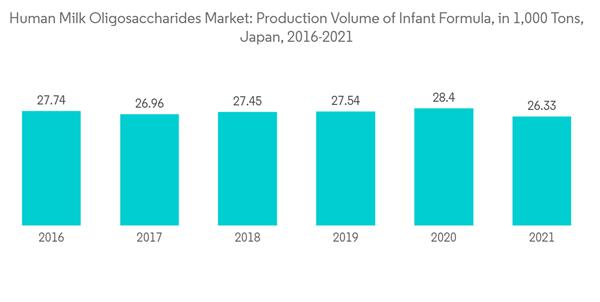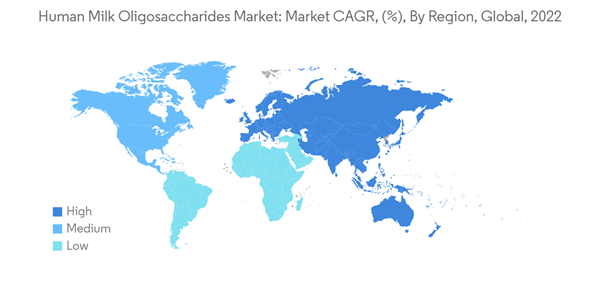The Global Human Milk Oligosaccharides Market size is estimated at USD 196.28 million in 2024, and is expected to reach USD 503.87 million by 2029, growing at a CAGR of 20.75% during the forecast period (2024-2029).
Human Milk Oligosaccharides (HMOs) are complex sugars available in human milk. They are the 3rd largest solid component in breast milk after fat and lactose and have no nutritive function. HMOs are responsible for directly stimulating the immune system by promoting good gut bacteria, strengthening the gut barrier function, and blocking pathogens. Changing consumer lifestyles and their increasing concerns regarding health and wellness are some of the other prominent factors driving the demand for HMOs around the world. Human milk oligosaccharides in functional food and beverage products and food supplements can help the treatment of certain disorders and high-risk health conditions, which in turn is anticipated to boost the product demand. Human milk oligosaccharides constitute a significant source of sialic acid, which is an essential part of the plasma membrane of nerve cells. Over 150 structurally diverse HMOs are available in nature. Moreover, scientists have been trying to develop various structures of HMOs synthetically for use in the food industry-most, particularly infant formulas and medical nutrition. These synthetically produced HMOs are safe for consumption by infants (who cannot be breastfed), as well as children and adults.
Human milk oligosaccharides find application in infant formula, functional food and beverages, and food supplements. Increasing health awareness and the rising consumption of infant formula are likely to boost the growth of the HMO market over the forecast period. The consumption of HMOs has contributed significantly catering to the rising concerns regarding health and safety, which are likely to boost market growth over the forecast period. HM, and Os play a key role in the proper development of infants. They fight life-threatening infections and are also responsible for properly developing the brain and gut.
For instance, in July 2021, Inbiose, one of the leading biotech companies active in the development of Human Milk Oligosaccharides (HMOs), announced that it submitted its application for a Generally Recognized as Safe (GRAS) approval by the US Food & Drug Administration (FDA) of four HMOs, specifically 6'-Sialyllactose (6'SL), 3-Sialyllactose (3'SL), Lacto-N-Tetraose (LNT) and Lacto-N-neoTetraose (LNnT). Inbiose announced that it would also file for Novel Food approval of these HMOs by the European Commission (EFSA) and is preparing a global regulatory roll-out. Inbiose planned to obtain regulatory approval for these HMOs in 2022 and was currently organizing its industrial production in infant nutrition, dietary supplements, and functional food and beverages.
Another factor boosting the human milk oligosaccharides market in Japan is the desire for high-nutrition foods and digestive supplements among both children and adults. HMOs, enhance metabolic activity by promoting bacterial growth in the stomach, particularly in the Bifidobacterium species. Japanese consumers have been very conscious about regularly replenishing the bacterial flora in their gut and perceive probiotic bacteria to be the best solution, which is further driving the market in the country.
This product will be delivered within 2 business days.
Human Milk Oligosaccharides (HMOs) are complex sugars available in human milk. They are the 3rd largest solid component in breast milk after fat and lactose and have no nutritive function. HMOs are responsible for directly stimulating the immune system by promoting good gut bacteria, strengthening the gut barrier function, and blocking pathogens. Changing consumer lifestyles and their increasing concerns regarding health and wellness are some of the other prominent factors driving the demand for HMOs around the world. Human milk oligosaccharides in functional food and beverage products and food supplements can help the treatment of certain disorders and high-risk health conditions, which in turn is anticipated to boost the product demand. Human milk oligosaccharides constitute a significant source of sialic acid, which is an essential part of the plasma membrane of nerve cells. Over 150 structurally diverse HMOs are available in nature. Moreover, scientists have been trying to develop various structures of HMOs synthetically for use in the food industry-most, particularly infant formulas and medical nutrition. These synthetically produced HMOs are safe for consumption by infants (who cannot be breastfed), as well as children and adults.
Human milk oligosaccharides find application in infant formula, functional food and beverages, and food supplements. Increasing health awareness and the rising consumption of infant formula are likely to boost the growth of the HMO market over the forecast period. The consumption of HMOs has contributed significantly catering to the rising concerns regarding health and safety, which are likely to boost market growth over the forecast period. HM, and Os play a key role in the proper development of infants. They fight life-threatening infections and are also responsible for properly developing the brain and gut.
Human Milk Oligosaccharides (HMO) Market Trends
Increasing Awareness About The Health Benefits Associated With HMO
Good nutrition helps build the foundation for a child's ability to learn, grow and thrive. For babies, the best nutrition is breast milk due to special prebiotics called human milk oligosaccharides (HMOs). They are the largest solid component of breast milk after carbohydrates and fat. Various clinical data in infants indicate that Human Milk Oligosaccharide helps to develop the desired microbiota by serving as a food source for the good bacteria in the intestine. Naturally occurring in breast milk, HMOs have evolved over thousands of years. HMO research (clinical and preclinical) suggests that specific HMOs at the correct level of supplementation can provide babies with unique health benefits. In particular, Human Milk Oligosaccharide supports immunity and gut health, with a potential role in cognitive development, which may open future innovation opportunities and thus, would increase the demand for HMOs globally. According to research conducted by Abbott Nutrition, a specific HMO, 2'-FL or 2'-Fucosyllactose, can provide health benefits to a growing baby and plays a role in supporting the development of a strong immune system.For instance, in July 2021, Inbiose, one of the leading biotech companies active in the development of Human Milk Oligosaccharides (HMOs), announced that it submitted its application for a Generally Recognized as Safe (GRAS) approval by the US Food & Drug Administration (FDA) of four HMOs, specifically 6'-Sialyllactose (6'SL), 3-Sialyllactose (3'SL), Lacto-N-Tetraose (LNT) and Lacto-N-neoTetraose (LNnT). Inbiose announced that it would also file for Novel Food approval of these HMOs by the European Commission (EFSA) and is preparing a global regulatory roll-out. Inbiose planned to obtain regulatory approval for these HMOs in 2022 and was currently organizing its industrial production in infant nutrition, dietary supplements, and functional food and beverages.
Asia-Pacific Holds a Singnificant Share in the Market
Asia-Pacific accounts for a significant market share; wherein, market growth includes an ever-expanding reach in infant formulas and functional beverages, the rise of the dairy industry, and rapid technological advancements in the product line. In addition, changes in lifestyles focused on nutritious foods are likely to increase the need for products. Among all the applications, the use in infant formulas registers significant participation with the rise in the inclusion of HMO in prebiotics in terms of volume for this market. Human Milk Oligosaccharides (HMO) respect the prebiotic properties as it helps develop commensal bacteria and the increasing demand for functional food, and dietary supplements for better health and digestion, the market for HMO is expected to grow in the region during the forecast period.Another factor boosting the human milk oligosaccharides market in Japan is the desire for high-nutrition foods and digestive supplements among both children and adults. HMOs, enhance metabolic activity by promoting bacterial growth in the stomach, particularly in the Bifidobacterium species. Japanese consumers have been very conscious about regularly replenishing the bacterial flora in their gut and perceive probiotic bacteria to be the best solution, which is further driving the market in the country.
Human Milk Oligosaccharides (HMO) Industry Overview
The global human milk oligosaccharides market is highly competitive with prominent players such as Koninklijke DSM N.V., Chr. Hansen Holding A/S, BASF SE, Inbiose NV, and International Flavors & Fragrances Inc. (DuPont). The major companies are investing highly in R&D, to develop products with similar health benefits as that of breast milk. Key strategies adopted by players in the market are product partnerships for extended research activities and new product launches. Key players established unique sales and distribution networks through partnerships with local establishments or offering products via interactive e-commerce channels to reach a wide range of consumers and expand into untapped markets.Additional Benefits:
- The market estimate (ME) sheet in Excel format
- 3 months of analyst support
This product will be delivered within 2 business days.
Table of Contents
1 INTRODUCTION
4 MARKET DYNAMICS
5 MARKET SEGMENTATION
6 COMPETITIVE LANDSCAPE
Companies Mentioned (Partial List)
A selection of companies mentioned in this report includes, but is not limited to:
- BASF SE
- Abbott Laboratories
- Chr. Hansen Holding A/S
- International Flavors & Fragrances Inc. (DuPont)
- Koninklijke DSM N.V.
- Merck & Co. Inc.
- Royal FrieslandCampina N.V.
- ZuChem Inc.
- Inbiose NV
- Glycosyn LLC
- Kirin Holdings Company (Kyowa Hakko Bio)
Methodology

LOADING...










